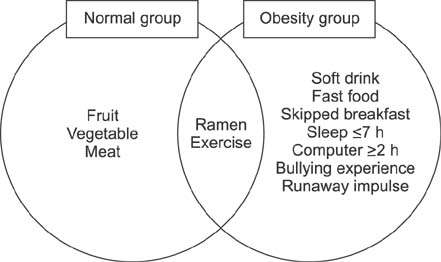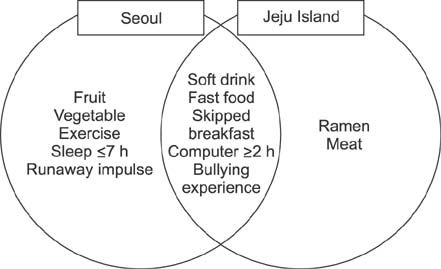The Analysis of Factors Causing the High Prevalence of Child Obesity in Jeju Island
- Affiliations
-
- 1Department of Pediatrics, Jeju National University School of Medicine, Jeju, Korea. kskang@jejunu.ac.kr
- KMID: 2409364
- DOI: http://doi.org/10.5223/pghn.2018.21.2.127
Abstract
- PURPOSE
For 3 consecutive years from 2012-2014, we analyzed the causative factors for why the Jeju Island had the highest obesity prevalences of school children among the 15 provinces in Korea.
METHODS
From our analysis of 28,026 elementary school children with obesity or normal weight in the 15 provinces, we analyzed 12 factors related to eating habits, exercise habits, lifestyle, and mental health. The differences between the obese and normal weight children were researched. Finally, Jeju was compared with Seoul, which has the lowest obesity prevalence in school age children. Statistical analysis was performed using the chi square test of PASW Statistics ver. 18.0.
RESULTS
Compared to the normal weight group, the obese group had significantly higher rates of consuming soft drinks (p<0.001), fast food intake (p=0.019), skipping breakfast (p<0.001), insufficient sleep (p<0.001), bullying experiences (p=0.001) and runaway impulses (p=0.012). Compared to Seoul, Jeju Island had significantly higher rates of Ramen intake (3.4% vs. 5.4%, p=0.021) and meat intake (46.0% vs. 52.9%, p=0.003). On the other hand, Jeju Island was significantly lower than was Seoul in their fruit intake (83.4% vs. 67.1%, p<0.001), vegetable intake (71.4% vs. 64.2%, p=0.001), and intense physical activity (63.4% vs. 47.7%, p<0.001). Meanwhile, insufficient sleep (15.4% vs. 9.6%, p<0.001) and runaway impulses (5.6% vs. 3.3%, p=0.027) in children were significantly lower in Jeju Island than in Seoul.
CONCLUSION
The results of the obesity factor analysis of elementary school students in Jeju Island can be used as useful educational material for lowering the obesity prevalence in Jeju community.
Keyword
MeSH Terms
Figure
Cited by 2 articles
-
Clinical Practice Guideline for the Diagnosis and Treatment of Pediatric Obesity: Recommendations from the Committee on Pediatric Obesity of the Korean Society of Pediatric Gastroenterology Hepatology and Nutrition
Dae Yong Yi, Soon Chul Kim, Ji Hyuk Lee, Eun Hye Lee, Jae Young Kim, Yong Joo Kim, Ki Soo Kang, Jeana Hong, Jung Ok Shim, Yoon Lee, Ben Kang, Yeoun Joo Lee, Mi Jin Kim, Jin Soo Moon, Hong Koh, JeongAe You, Young-Sook Kwak, Hyunjung Lim, Hye Ran Yang
Pediatr Gastroenterol Hepatol Nutr. 2019;22(1):1-27. doi: 10.5223/pghn.2019.22.1.1.Visual Hyper-vigilance But Insufficient Mental Representation in Children with Overweight/Obesity: Event-related Potential Study with Visual Go/NoGo Test
Inkyu Gill, Jin-Hwa Moon, Yong Joo Kim, Ja Hye Kim, Dong Hyun Ahn, Min Sook Koh
Pediatr Gastroenterol Hepatol Nutr. 2019;22(3):249-261. doi: 10.5223/pghn.2019.22.3.249.
Reference
-
1. Kang KS. Nutritional counseling for obese children with obesity-related metabolic abnormalities in Korea. Pediatr Gastroenterol Hepatol Nutr. 2017; 20:71–78.
Article2. Oh MS, Kim S, Jang JH, Park JY, Kang HS, Lee MS, et al. Associations among the degree of nonalcoholic fatty liver disease, metabolic syndrome, degree of obesity in children, and parental obesity. Pediatr Gastroenterol Hepatol Nutr. 2016; 19:199–206.
Article3. Minstry of Education, Republic of Korea. Report of student health test results 2012 [Internet]. Seoul: Ministry of Education;2013. cited 2017 Oct 6. Available from: https://goo.gl/BdKCcV.4. Ministry of Education, Republic of Korea. Report of student health test results 2013 [Internet]. Seoul: Ministry of Education;2014. cited 2017 Oct 6. Available from: https://goo.gl/xzaVwK.5. Ministry of Education. Republic of Korea. Report of student health test results 2014 [Internet]. Seoul: Ministry of Education;2014. cited 2017 Oct 6. Available from: https://goo.gl/mwWsKf.6. Seo JH. The prevalence of childhood and adolescent obesity in Jeju and clinical characteristics according to the degree of obesity. Korean J Pediatr. 2004; 47:362–367.7. Jee YJ, Kim YH. Factors influencing obesity among adolescent: analysis of 2011 Korean youth risk behavior survey. Korean J Obes. 2013; 22:39–49.
Article8. Camargo JM, Marín-León L. Factors associated with overweight among elementary schoolchildren in Campinas, São Paulo, Brazil. Rev Nutr. 2016; 29:401–413.
Article9. Janssen I, Katzmarzyk PT, Boyce WF, Vereecken C, Mulvihill C, Roberts C, et al. Comparison of overweight and obesity prevalence in school-aged youth from 34 countries and their relationships with physical activity and dietary patterns. Obes Rev. 2005; 6:123–132.
Article10. Maddah M, Nikooyeh B. Factors associated with overweight in children in Rasht, Iran: gender, maternal education, skipping breakfast and parental obesity. Public Health Nutr. 2010; 13:196–200.
Article11. Szajewska H, Ruszczynski M. Systematic review demonstrating that breakfast consumption influences body weight outcomes in children and adolescents in Europe. Crit Rev Food Sci Nutr. 2010; 50:113–119.
Article12. Kim B, Lee CY, Kim HS, Ko IS, Park CG, Kim GS. Ecological risk factors of childhood obesity in Korean elementary school students. West J Nurs Res. 2012; 34:952–972.
Article13. Van Cauter E, Knutson KL. Sleep and the epidemic of obesity in children and adults. Eur J Endocrinol. 2008; 159:Suppl 1. S59–S66.
Article14. Li L, Shen T, Wen LM, Wu M, He P, Wang Y, et al. Lifestyle factors associated with childhood obesity: a cross-sectional study in Shanghai, China. BMC Res Notes. 2015; 8:6.
Article15. Park KW, Lee K, Park TJ, Kwon ER, Ha SJ, Moon HJ, et al. The factors associated with becoming obese children: in 6th grade children of elementary schools in Busan. J Korean Acad Fam Med. 2003; 24:739–745.16. Peltzer K, Pengpid S. Overweight and obesity and associated factors among school-aged adolescents in Ghana and Uganda. Int J Environ Res Public Health. 2011; 8:3859–3870.
Article17. Janssen I, Craig WM, Boyce WF, Pickett W. Associations between overweight and obesity with bullying behaviors in school-aged children. Pediatrics. 2004; 113:1187–1194.
Article
- Full Text Links
- Actions
-
Cited
- CITED
-
- Close
- Share
- Similar articles
-
- The Prevalence and Related Factors of Depressive Symptoms among the Elderly in Rural Areas of Jeju Island
- Nutritional Counseling for Obese Children with Obesity-Related Metabolic Abnormalities in Korea
- The Comparison of Efficacy of Obesity Indices for Screening Metabolic Risk Factors Among Adults In Jeju Island
- The Prevalence of Gallstone Disease Is Significantly Lower in Natives than in Migrants of Jeju Island
- A case of Enterovirus 71 Infection Presented with Acute Flaccid Paralysis in Jeju Island



